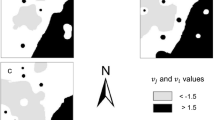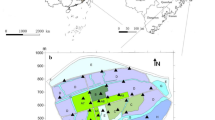Abstract
The diamondback moth (DBM), Plutella xylostella is a serious pest of crucifers causing enormous damages on different crops of Brassica genus. The present study evaluated the impact of meteorological parameters on the population dynamics of P. xylostella. During 2018, four sites in four different regions of Tunisia served for the study and two other different sites in 2019. Obtained results showed a variation in population dynamics of P. xylostella between different investigated sites and during both years. Appearance of the larvae in 2018 was registered in March and since February 2019. Most important peaks of larvae and pupae population were recorded during April and May. Results showed a correlation between meteorological parameters and pest occurrence, especially temperature where correlations were positive. Degree-Day Growth (DDG) analysis was demonstrated according to lower threshold of temperature of the pest. It was situated between 5.5 and 13 °C during March in 2018 and it started from 4.7 °C in February in 2019. Correlations and DDG determination permitted to identify critical periods of the pest outbreak for future management. Infestation rates were noted from first dates of appearance of the pest between March and April during 2018 and since February in 2019 reaching 90 to 100% by the end of observations. Parasitism of P. xylostella larvae and pupae reached high values (ranking between 70 and 100%) during April and May. The population dynamics of P. xylostella is characterized by seasonal changes in abundance caused by differences in meteorological parameters that could make its management and monitoring difficult.













Similar content being viewed by others
References
Ahmad T, Ansari SA (2010) Studies on seasonal abundance of diamondback moth Plutella xylostella (Lepidoptera: Yponomeutidae) on cauliflower crop. J Plant Prot Res 50(3):280–287. https://doi.org/10.2478/v10045-010-0049-6
Ahmad B, Saljoqi AUR, Zada H, Sattar S, Iqbal T, Hussain S, Saeed M (2018) Effect of weather on diamond back moth, Plutella xylostella (L.) (Lepidoptera: Plutellidae) in district Haripur. Sarhad J Agric 34(1):209–214. https://doi.org/10.17582/journal.sja/2018/34.1.209.214
Ayalew G, Baumgärtner J, Callistus Ogol KPO, Löhr B (2007) Analysis of population dynamics of diamondback moth, Plutella xylostella (Lepidoptera: Plutellidae) at two sites in central Ethiopia, with particular reference to parasitism. Biocontrol Sci Technol 16(6):607–618. https://doi.org/10.1080/09583150600699697
Bahar MH, Soroka JJ, Grenkow L, Dosdall LM (2014) New threshold temperatures for the development of a North American diamondback moth (Lepidoptera: Plutellidae) population and its larval parasitoid, Diadegma insulare (Hymenoptera: Ichneumonidae). Environ Entomol 43(5):1443–1452. https://doi.org/10.1603/EN14055
Baker CRB (1980) Some problems in using meteorological data to forecast the timing of insect life cycles. EPPO Bull 10:83–91. https://doi.org/10.1111/j.1365-2338.1980.tb02628.x
Bessin R, Villanueva R (2019) Predicting insect development using insect degree days. Cooperative extension service. University of Kentucky college of agriculture, food and environment, Lexington, KY 40546. Entfact-123. https://entomology.ca.uky.edu/files/efpdf1/ef123.pdf. Accessed 11 Jan 2021
Bhagat P, Yadu YK, Sharma GL (2018) Seasonal incidence and effect of abiotic factors on population dynamics of diamondback moth (Plutella xylostella L.) on cabbage (Brassica oleracea var. Capitata L.) crop. J Entomol Zool Stud 6(2):2001–2003
Butts RA, McEwen FL (1981) Seasonal populations of the diamondback moth, Plutella xylostella (Lepidoptera: Plutellidae) in relation to day-degree accumulation. Can Entomol 113(2):127–131. https://doi.org/10.4039/Ent113127-2
Chandramohan N (1994) Seasonal incidence of diamondback moth, Plutella xylostella L. and its parasitoids in Nilgiris. J Biol Control 8(2):77–80. https://doi.org/10.5897/JPBCS10.004
Collier RH, Finch S (2001) Forecasting attacks by pest insects of cruciferous crops. In: The management of diamondback moth and other crucifer pest. Proceedings of the 4th International Workshop, November 2001, Melbourne, Australia, pp 163–168
Feng X, Li ZY, Wu QJ, Chen AD, Wu YD, Hou YM, He YR, Li JH, Xie SH, Zhang JM, Fu W, Ma CS (2011) Research progress of the resistance management and sustainable control of diamondback moth. Chin J Entomol 48:247–253
Furlong MJ, Wright DJ, Dosdall LM (2013) Diamondback moth ecology and management: problems, progress, and prospects. Annu Rev Entomol 58:517–541. https://doi.org/10.1146/annurev-ento-120811-153605
Golizadeh ALI, Kamali K, Fathipour Y, Abbasipour H (2007) Temperature-dependent development of diamondback moth, Plutella xylostella (Lepidoptera: Plutellidae) on two brassicaceous host plants. Insect Sci 14(4):309–316. https://doi.org/10.1111/j.1744-7917.2007.00157.x
Golizadeh A, Kamali K, Fathipour Y, Abbasipour H (2009) Effect of temperature on life table parameters of Plutella xylostella (Lepidoptera: Plutellidae) on two brassicaceous host plants. J Asia-Pac Entomol 12(2):207–212. https://doi.org/10.1016/j.aspen.2009.05.002
Harcourt DG (1986) Population dynamics of the diamondback moth in southern Ontario. In: Talekar NS, Griggs TD (Eds) Diamondback moth management. Proceedings of first international workshop, asian vegetable research and development center, Shanhua, Taiwan, pp 3–15
Jat GC, Lekh A, Jat SK, Yadav PC (2017) Effect of weather parameters on the incidence of major insect pests of cabbage. Int J Agric Sci 9(6):4133–4135
Kfir R (1997) Parasitoids ofPlutella xylostella (Lep.: Plutellidae) in South Africa: an annotated list. Entomophaga 42:517–523. https://doi.org/10.1007/BF02769811
Labou B, Brevault T, Bordat D, Diarra K (2016) Determinants of parasitoid assemblages of the diamondback moth, Plutella xylostella, in cabbage farmer fields in Senegal. J Crop Prot 89:6–11. https://doi.org/10.1016/j.cropro.2016.06.018
Li Z, Feng X, Liu SS, You M, Furlong MJ (2016) Biology, ecology, and management of the diamondback moth in China. Annu Rev Entomol 61:277–296. https://doi.org/10.1146/annurev-ento-010715-023622
Lin QS, Jin FL, Hu ZD, Chen HY, Yin F, Li Z, Dong X, Zhang D, Ren S, Feng X (2013) Transcriptome analysis of chlorantraniliprole resistance development in the diamondback moth Plutella xylostella. PLoS ONE 8(8):e72314. https://doi.org/10.1371/journal.pone.0072314
Liu SS, Chen FZ, Zalucki MP (2002) Development and survival of the diamondback moth, Plutella xylostella (Lepidoptera: Plutellidae), at constant and alternating temperatures. Environ Entomol 31:1–12. https://doi.org/10.1603/0046-225X-31.2.221
Marchioro CA, Foerster LA (2011) Development and survival of the Diamondback Moth, Plutella xylostella (L.) (Lepidoptera: Yponomeutidae) as a function of temperature: effect on the number of generations in tropical and subtropical regions. Neotrop Entomol 40(5):533–541. https://doi.org/10.1590/S1519-566X2011000500003
Marchioro CA, Foerster LA (2016) Biotic factors are more important than abiotic factors in regulating the abundance of Plutella xylostella L. in Southern Brazil. Rev Bras Entomol 60(4):328–333. https://doi.org/10.1016/j.rbe.2016.06.004
McMaster GS, Wilhelm WW (1997) Growing degree-days: one equation, two interpretations. Agric For Meteorol 87(4):291–300. https://doi.org/10.1016/S0168-1923(97)00027-0
Mitchell ER, Hu GY, Okine JS, Carpenter JE (1999) Parasitism of diamondback moth (Lepidoptera: Plutellidae) larvae by Cotesia plutellae (Hymenoptera: Braconidae) and Diadegma insulare (Hymenoptera: Ichneumonidae) in cabbage fields after inundative releases of C. plutellae. Entomol Sci 34(1):101–112. https://doi.org/10.18474/0749-8004-34.1.101
Murray MS (2008) Using degree days to time treatments for insect pests. Utah State University Extension and Utah Plant Pest Diagnostic Laboratory, IPM-05–08. https://core.ac.uk/download/pdf/77520811.pdf. Accessed 22 Jan 2021
Ngowi BV, Tonnang HEZ, Mwangi EM, Johansson T, Ambale J, Ndegwa PN, Subramanian S (2017) Temperature-dependent phenology of Plutella xylostella (Lepidoptera: Plutellidae): simulation and visualization of current and future distributions along the Eastern Afromontane. PLoS ONE 12(3):1–24. https://doi.org/10.1371/journal.pone.0173590
Patra S, Dhote VW, Alam SKF, Das BC, Chatterjee ML, Samanta A (2013) Population dynamics of major insect pests and their natural enemies on cabbage under new alluvial zone of West Bengal. J Plant Prot Sci 5(1):42–49
Ruscha A, Valantin-Morisona M, Sarthoub JP, Roger-Estradea J (2013) Effect of crop management and landscape context on insect pest populations and crop damage. Agric Ecosyst Environ 166:118–125. https://doi.org/10.1016/j.agee.2011.05.004
Sharma P, Kumawat KC, Jhumar L (2017) Seasonal abundance of diamondback moth and natural enemies on cabbage. J Entomol Zool Stud 5(3):176–179
Sithole R, Nyamukondiwab C, Chinwadac P, Lohra B (2019) Population dynamics of the diamondback moth and its parasitoids in Zimbabwe. Biol Control 133:66–74. https://doi.org/10.1016/j.biocontrol.2019.03.008
Sow G, Diarra K, Arvanitakis L, Bordat D (2013a) The relationship between the diamondback moth, climatic factors, cabbage crops and natural enemies in a tropical area. Folia Hortic 25(1):3–12. https://doi.org/10.2478/fhort-2013-0001
Sow G, Arvanitakis L, Niassy S, Diarra K, Bordat D (2013b) Life history raits of Oomyzus sokolowskii Kurdjumov (Hymenoptera: Eulophidae), a parasitoid of the diamondback moth. Afr Entomol 21(2):231–238. https://doi.org/10.4001/003.021.0202
Su C, Xia X (2020) Sublethal effects of methylthio-diafenthiuron on the life table parameters and enzymatic properties of the diamondback moth, Plutella xylostella (L.) (Lepidoptera: Plutellidae). Pesticide Biochem Physiol 162:43–51. https://doi.org/10.1016/j.pestbp.2019.08.011
Talekar NS, Shelton AM (1993) Biology, ecology, and management of the diamondback moth. Annu Rev Entomol 38:275–301. https://doi.org/10.1146/annurev.en.38.010193.001423
Talekar NS (1992) Management of diamondback moth and other crucifer pests: proceedings of the second international workshop. Asian Vegetable Research and Development Center, Shanhua, Taiwan
Venkateswarlu V, Rk S, Chander S, Singh SD (2011) Population dynamics of major insect pests and their natural enemies in cabbage. Ann Plant Prot Sci 19(2):272–277
Wang EG, Zheng YL (2007) Seasonal abundance of diamondback moth, Plutella xylostella, adult in Linhai, Zhejiang. Chin J Entomol 44:271–274
Wang JW, Wu HS, Lin Y (1991) Study on the biology and control of diamondback moth, Plutella xylostella, in Hainan Island. J Hunan Univ Nat Sci 9:41–48
Zhou CB, Lin ZF, Xie SH, Ji XC (2010) Population dynamics of Plutella xylostella and its influence factors in Hainan. Plant Prot Sci 36:118–122
Zhu L, Li Z, Zhang S, Xu B, Zhang Y, Zalucki MP, Wu Q, Yin Q (2018) Population dynamics of the diamondback moth, Plutella xylostella (L.) in northern China: the effects of migration, cropping patterns and climate. Pest Manag Sci 74(8):1845–1853. https://doi.org/10.1002/ps.4885
Acknowledgements
The authors would like to thank the growers of the governorate of Zaghouan in Tunisia who kindly accepted to conduct this study.
Author information
Authors and Affiliations
Corresponding author
Ethics declarations
Conflict of interest
The authors declare that they have no conflict of interest.
Additional information
Publisher's note
Springer Nature remains neutral with regard to jurisdictional claims in published maps and institutional affiliations.
Rights and permissions
Springer Nature or its licensor (e.g. a society or other partner) holds exclusive rights to this article under a publishing agreement with the author(s) or other rightsholder(s); author self-archiving of the accepted manuscript version of this article is solely governed by the terms of such publishing agreement and applicable law.
About this article
Cite this article
Elimem, M., Kalboussi, M., Lahfef, C. et al. The diamondback moth in Tunisia: risk analysis, and influence of biotic and meteorological parameters on its population dynamics. Biologia 78, 1035–1045 (2023). https://doi.org/10.1007/s11756-022-01305-2
Received:
Accepted:
Published:
Issue Date:
DOI: https://doi.org/10.1007/s11756-022-01305-2




